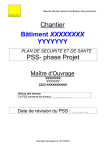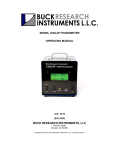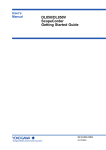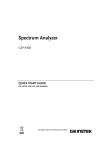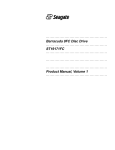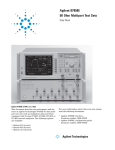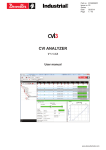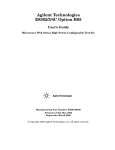Download Agilent Technologies N4970A User guide
Transcript
Agilent N4970A PRBS Generator 10 Gb/s User Guide Notices © Agilent Technologies, Inc. 2012 No part of this manual may be reproduced in any form or by any means (including electronic storage and retrieval or translation into a foreign language) without prior agreement and written consent from Agilent Technologies, Inc. as governed by United States and international copyright laws. Manual Part Number N4970-91021 Edition Second edition, May 2013 Agilent Technologies, Deutschland GmbH Herrenberger Str. 130 71034 Böblingen, Germany For Assistance and Support http://www.agilent.com/find/assist Limitation of Warranty The foregoing warranty shall not apply to defects resulting from improper or inadequate maintenance by Buyer, Buyer-supplied software or interfacing, unauthorized modification or misuse, operation outside of the environmental specifications for the product, or improper site preparation or maintenance. No other warranty is expressed or implied. Agilent Technologies specifically disclaims the implied warranties of Merchantability and Fitness for a Particular Purpose. Warranty The material contained in this document is provided “as is,” and is subject to being changed, without notice, in future editions. Further, to the maximum extent permitted by applicable law, Agilent disclaims all warranties, either express or implied, with regard to this manual and any information contained herein, including but not limited to the implied warranties of merchantability and fitness for a particular purpose. Agilent shall not be liable for errors or for incidental or consequential damages in connection with the furnishing, use, or performance of this document or of any information contained herein. Should Agilent and the user have a separate written agreement with warranty terms covering the material in this document that conflict with these terms, the warranty terms in the separate agreement shall control. Technology Licenses The hardware and/or software described in this document are furnished under a license and may be used or copied only in accordance with the terms of such license. Restricted Rights Legend If software is for use in the performance of a U.S. Government prime contract or subcontract, Software is delivered and licensed as “Commercial computer software” as defined in DFAR 252.227-7014 (June 1995), or as a “commercial item” as defined in FAR 2.101(a) or as “Restricted computer software” as defined in FAR 52.227-19 (June 1987) or any equivalent agency regulation or contract clause. Use, duplication or disclosure of Software is subject to Agilent Technologies’ standard commercial license terms, and non-DOD Departments and Agencies of the U.S. Government will receive no greater than Restricted Rights as defined in FAR 52.227-19(c)(1-2) (June 1987). U.S. Government users will receive no greater than Limited Rights as defined in FAR 52.227-14 (June 1987) or DFAR 252.227-7015 (b)(2) (November 1995), as applicable in any technical data. Safety Notices CAUTION A CAUTION notice denotes a hazard. It calls attention to an operating procedure, practice, or the like that, if not correctly performed or adhered to, could result in damage to the product or loss of important data. Do not proceed beyond a CAUTION notice until the indicated conditions are fully understood and met. WARNING A WARNING notice denotes a hazard. It calls attention to an operating procedure, practice, or the like that, if not correctly performed or adhered to, could result in personal injury or death. Do not proceed beyond a WARNING notice until the indicated conditions are fully understood and met. NOTE A NOTE provides important or special information. Safety Summary General Safety Precautions General Ground the Instrument The following general safety precautions must be observed during all phases of operation of this instrument. Failure to comply with these precautions or with specific warnings elsewhere in this manual violates safety standards of design, manufacture, and intended use of the instrument. This product is a Safety Class 1 product (provided with a protective earthing ground incorporated in the power cord). The mains plug shall only be inserted in a socket outlet provided with a protective earth contact. Any interruption of the protective conductor, inside or outside of the instrument, will make the instrument dangerous. Intentional interruption is prohibited. Agilent Technologies Inc. assumes no liability for the customer's failure to comply with these requirements. Environment Conditions Install the instrument so that the ON / OFF switch is readily identifiable and is easily reached by the operator. The ON / OFF switch is the instrument disconnecting device. It disconnects the mains circuits from the mains supply before other parts of the instrument. Or the detachable power cord can be removed from the electrical supply. Alternately, an externally installed switch or circuit breaker which is readily identifiable and is easily reached by the operator may be used as a disconnecting device. Before operation, review the instrument and manual for safety markings and instructions. You must follow these to ensure safe operation and to maintain the instrument in safe condition. Initial Inspection Inspect the shipping container for damage. If there is damage to the container or cushioning, keep them until you have checked the contents of the shipment for completeness and verified the instrument both mechanically and electrically. The Performance Tests give procedures for checking the operation of the instrument. If the contents are incomplete, mechanical damage or defect is apparent, or if an instrument does not pass the operator’s checks, notify the nearest Agilent Technologies Sales/Service Office. WARNING To avoid hazardous electrical shock, do not perform electrical tests when there are signs of shipping damage to any portion of the outer enclosure (covers, panels, etc.). This instrument is intended for indoor use in an installation category II, pollution degree 2 environment per IEC 61010 Second Edition and 664 respectively. It is designed to operate within a temperature range of 10 to 40 °C at a maximum relative humidity of 80% for temperatures up to 31 °C, decreasing linearly to 50% relative humidity at 40 °C at an altitude of 2000 meters. This module can be stored or shipped at temperatures between -40°C and +70°C. Protect the module from temperature extremes that may cause condensation within it. Before Applying Power Verify that all safety precautions are taken. The power cable inlet of the instrument serves as a device to disconnect from the mains in case of hazard. The instrument must be positioned so that the operator can easily access the power cable inlet. When the instrument is rack mounted the rack must be provided with an easily accessible mains switch. Do Not Operate in an Explosive Atmosphere Do not operate the instrument in the presence of flammable gases or fumes. Do Not Remove the Instrument Cover Operating personnel must not remove instrument covers. Component replacement and internal adjustments must be made only by qualified personnel. Instruments that appear damaged or defective should be made inoperative and secured against unintended operation until they can be repaired by qualified service personnel. Symbols on Instruments Indicates warning or caution. If you see this symbol on a product, you must refer to the manuals for specific Warning or Caution information to avoid personal injury or damage to the product. C-Tick Conformity Mark of the Australian ACA for EMC compliance. CE Marking to state compliance within the European Community: This product is in conformity with the relevant European Directives: EMC Directive 2004/108/EC and Low Voltage Directive 2006/95/EC. This symbol indicates that internal circuits can be damaged by electrostatic discharge (ESD), therefore, avoid applying static discharges to the panel input connectors. Indicates that protective earthing ground is incorporated in the power cord. This mark indicates compliance with the Canadian EMC regulations. The Korean Certification (KC) mark is required for products that are subject to legally compulsory certification. The KC mark includes the marking’s identifier code that has up to 26 digits and follows this format: KCC-VWX-YYY-ZZZZZZZZZZZZZ. This symbol indicates that the instrument requires alternating current (AC) input. This symbol indicates that the power line switch is in the ON position. China RoHS regulations include requirements related to packaging, and require compliance to China standard GB18455-2001. This symbol indicates compliance with the China RoHS regulations for paper/fiberboard packaging. ISM 1-A This text denotes the instrument is an Industrial Scientific and Medical Group 1 Class A product. Indicates the time period during which no hazardous or toxic substance elements are expected to leak or deteriorate during normal use. Forty years is the expected useful life of the product. O This symbol indicates that the power line switch is in the OFF position. Environmental Information This product complies with the WEEE Directive (2002/96/EC) marketing requirements. The affixed label indicates that you must not discard this electrical/electronic product in domestic household waste. Product category: With reference to the equipment types in the WEEE Directive Annexure I, this product is classed as a “Monitoring and Control instrumentation” product. Do not dispose in domestic household waste. To return unwanted products, contact your local Agilent office, or see www.agilent.com/environment/product/ for more information. Contents Contents 1 2 Getting Started ......................................................................................................... 9 1.1 Unpacking and Installation ............................................................................ 9 1.2 Important Notes............................................................................................. 10 1.3 Performance Recommendations................................................................. 10 N4970A Operation Overview ................................................................................. 11 2.1 Features........................................................................................................... 11 2.2 N4970A System Overview............................................................................ 12 2.3 Options ............................................................................................................ 13 2.4 Front Panel Quick Reference ....................................................................... 14 2.5 Rear Panel Quick Reference ........................................................................ 15 2.6 Safety and Regulatory................................................................................... 18 2.6.1 3 4 Performance Specifications.................................................................................. 19 3.1 General ............................................................................................................ 19 3.2 N4970A PRBS Generator Specifications ................................................... 20 Operation ................................................................................................................. 21 4.1 General Information ...................................................................................... 21 4.1.1 4.1.2 5 Declaration of Conformity ............................................................. 18 Performance Recommendations.................................................. 22 Connector Care ............................................................................... 22 4.2 Configuring Patterns or Mark Density ....................................................... 23 4.3 Resetting the N4970A................................................................................... 24 4.4 Input and Output Connectors ...................................................................... 24 4.5 System Verification ....................................................................................... 25 4.6 Simple Functional Example of N4970A use .............................................. 28 Returning the N4970A to Agilent Technologies ................................................ 29 PRBS Generator 10 Gb/s User Guide 7 Getting Started 8 PRBS Generator 10 Gb/s User Guide Getting Started 1 Getting Started 1.1 Unpacking and Installation The N4970A PRBS generator 10 Gb/s is shipped with all the accessories required for the self-test mode and verification. The shipment includes: • • • • N4970A PRBS generator 10 Gb/s AC power converter module AC power cord CD containing the N4970A user guide and N4970A data sheet If this product is not used as specified, the protection provided by the equipment could be impaired. This product must be used in a normal condition (in which all means for protection are intact) only. Before switching on this instrument, make sure the supply voltage is in the specified range. This instrument has auto ranging line voltage input. Be sure the supply voltage is within the specified range. To prevent damage to the instrument, make all RF connections between the N4970A and the DUT or test equipment BEFORE applying AC power to the N4970A. Also, remove AC power from the N4970A instrument before disconnecting any RF connections. PRBS Generator 10 Gb/s User Guide 9 Getting Started In an ESD-safe environment, carefully remove the N4970A from the packaging. Install on a flat surface with unobstructed air flow to the back panel. Make all RF connections between the N4970A and the DUT or test equipment BEFORE applying AC power by plugging the converter module into the N4970A. Also, remove AC power from the N4970A instrument before disconnecting any RF connections. Plug the AC power cord into the power converter module and a wall socket, then plug the converter module into the N4970A. 1.2 Important Notes • • • • • Use ESD protection at all times when using the system. Review min/max specifications before applying input signals. Use only SMA-connectors on the RF ports. Use dust jackets on unused back panel connectors. Situate the instrument away from heat sources. 1.3 Performance Recommendations 1. When using differential-mode connections, ensure the cables are phase balanced. 2. Differential connectors may be used single-ended if second end terminated in 50 Ω. 3. Use high quality cables and connector savers (or adaptors). 4. Keep cable lengths short and minimize number of cable bends. 5. Use a 7 to 10 in-lbs torque wrench when attaching connectors. 10 PRBS Generator 10 Gb/s User Guide N4970A Operation Overview 2 N4970A Operation Overview The N4970A is a Pseudo Random Bit Stream (PRBS) generator with an internal clock that can be factory set from a selection of frequencies around 10 GHz, and can also be user-configured to use a 0.05 to 12.5 GHz clock signal from an external source. The N4970A features low jitter, fast rise and fall times, and a clean eye pattern. The source provides five selectable pattern lengths and three selectable mark densities. The N4970A comes in an easy to use compact (3.5 x 3.5 x 1.0 inch) package. The PRBS generator provides the "clean eye" needed to evaluate the performance of optical system components or complete systems, e.g. SONET/SDH, 10 Gb/s ethernet, XAUI, etc. 2.1 Features • • • • • • • • PRBS Generator 10 Gb/s User Guide Single-frequency clock source Wide operating range, up to 12.5 Gb/s (external clock) RMS jitter ~ 1.0 ps Fast rise/fall times Small size: 3.5" x 3.5" x 1" Multiple output patterns: 27-1, 210-1, 215-1, 223-1, 231-1 Multiple mark ratios: 1/2, 1/4, 1/8 Differential outputs 11 N4970A Operation Overview 2.2 N4970A System Overview The N4970A provides a Pseudo Random Bit Stream (PRBS) referenced to either the factory-set internal clock frequency or an external clock (0.05 GHz to 12.5 GHz). The N4970A generates a bit stream equal to the clock frequency, eg: 9.95328 GHz = 9.95328 Gb/s (SONET 10G). The PRBS pattern length and mark density features can be selected by the user. The pattern length and mark density settings are indicated on the front panel of the N4970A. When the N4970A is used in conjunction with a digital communications analyzer, accurate high resolution measurements of electrical and optical components or systems can be performed. For R&D applications the N4970A source provides the engineer with a fast rise/fall time, low jitter data stream which is useful in the development of datacom/telecom products. Accurate repeatable eye pattern measurements provide a valuable development tool for evaluating and comparing the performance of design, or components. The small size of the N4970A (3.5 x 3.5 x 1.0 inch) allows close placement to DUT eliminating losses and distortion from long cables. The N4970A factoryset internal clock can be used to eliminate the need for additional test equipment clock signal generator or oscilloscope trigger divider. In the manufacturing environment, the N4970A source provides a cost effective solution for evaluating and tuning communication systems such as SONET/SDH, 10 Gb/s Ethernet, fiber channel, XAUI, etc. 12 PRBS Generator 10 Gb/s User Guide N4970A Operation Overview Figure 1. 10 Gb/s eye output 2.3 Options The N4970A is available with the following build options: • • • • • • • • PRBS Generator 10 Gb/s User Guide Standard: 10 Gb/s data rate operation 300 mV p-p output N4970A-010: extended amplitude range 750 mV p-p output N4970A-301: internal clock frequency at 10.66423 GHz N4970A-302: internal clock frequency at 10.51875 GHz N4970A-303: internal clock frequency at 11.09573 GHz N4970A-304: internal clock frequency at 9.95328 GHz N4970A-305: internal clock frequency at 10.709225 GHz N4970A-306: internal clock frequency at 10.3125 GHz 13 N4970A Operation Overview 2.4 Front Panel Quick Reference Figure 2. N4970A front panel RESET: A momentary reset switch provides a means to restart the bit stream from an all zero condition. Output: The PRBS signal is available as a differential signal on the SMA female output terminals. Terminate unused outputs. Impedance: 50 Ω Max DC: ±5V Nominal DC: 0V AC Level: > 300 mV p-p typical, single-ended > 750 mV p-p typical, single-ended (Option 010) ESD sensitive; terminate if unused. DC Blocked. 14 PRBS Generator 10 Gb/s User Guide N4970A Operation Overview LED indicators: Eight LED annunciators are provided on the front panel. The first five indicate the selected pattern length. The next three indicate the selected mark density as illustrated below. Figure 3. N4970A front panel 2.5 Rear Panel Quick Reference Figure 4. N4970A rear panel Power: Negative 5 Vdc @ 1 A (center pin negative) is supplied, by the power supply module, to this terminal to power the PRBS source. Use only the AC/DC adapter provided with the N4970A. PRBS Generator 10 Gb/s User Guide 15 N4970A Operation Overview Rear connector: Eight sets of pins are provided to select the pattern length and mark density. A separate pair of pins is provided to allow remote reset. Two jumpers are used to select the desired pattern length and mark density. Install the jumpers in the desired positions for stand-alone operation. Refer to Figure 5. A cable can be connected to the pins for remote operation. CKO output: A female SMA connector is provided for the internal clock output. The clock is factory-set and cannot be adjusted. Impedance: 50 Ω Max DC: ±5V Nominal DC: 0V AC output: 600 mV nominal ESD sensitive; terminate if unused. DC Blocked. Clk input: A female SMA connector is provided for the PRBS clock input, which establishes the timing of the PRBS. A rigid coax loop is supplied to connect the CKO output to the CKI input; supply an external clock signal to the CKI input after removing the coax loop. Impedance: 50 Ω Max DC: ±5V Nominal DC: 0V AC input: 2 V p-p (+10 dBm) typical < 1 GHz 890 mV p-p (+3 dBm) typical ≥ 1 GHz ESD sensitive; terminate if unused. DC Blocked. 16 PRBS Generator 10 Gb/s User Guide N4970A Operation Overview CKO/16 output: A female SMA connector provides a divided-by-16 clock output (CKO/16 = CKI div 16) for triggering. Impedance: 50 Ω Max DC: ±5V Nominal DC: 0V AC output: 600 mV p-p nominal DC Blocked. Figure 5. N4970A rear panel PRBS Generator 10 Gb/s User Guide 17 N4970A Operation Overview 2.6 Safety and Regulatory This product has been designed and tested in accordance with accepted industry standards, and has been supplied in a safe condition. The documentation contains information and warnings that must be followed by the user to ensure safe operation and to maintain the product in a safe condition. Do not remove instrument covers. There are no user serviceable parts within. Operation of the instrument in a manner not specified by Agilent Technologies may result in personal injury or loss of life. To prevent electrical shock, disconnect instrument from mains before cleaning. Use a dry cloth or one slightly dampened with water to clean the external case parts. Do not attempt to clean internally. For continued protection against fire hazard, replace fuses, and or circuit breakers only with same type and ratings. The use of other fuses, circuit breakers or materials is prohibited The Mains wiring and connectors shall be compatible with the connector used in the premise electrical system. Failure, to ensure adequate earth grounding by not using the correct components may cause product damage, and serious injury. 2.6.1 Declaration of Conformity A EU declaration of conformity is available at http://regulations.corporate.agilent.com/doc/search.htm 18 PRBS Generator 10 Gb/s User Guide Performance Specifications 3 Performance Specifications Specifications describe the instrument’s warranted performance. Nonwarranted values are stated as typical. All specifications are valid in a range from 10 °C to 40 °C ambient temperature after a 30 minute warm-up phase. 3.1 General Table 1. General and mechanical parameters of N4970A Operating Temperature +10 to +40 °C Storage Temperature –40 to +70°C Power Requirements 42 W External AC Adaptor (included) Physical Dimensions (W x H x D) • 100 to 240 VAC, 50 to 60 Hz 3.5 x 1.0 x 3.5 inches Weight 0.22 kg (0.5 lbs) EMC Complies with European EMC Directive 2004/108/EC • • • • IEC/EN 61326-1 CISPR Pub 11 Group 1, class A AS/NZS CISPR 11 ICES/NMB-001 This ISM device complies with Canadian ICES-001. Cet appareil ISM est conforme a la norme NMB-001 du Canada. PRBS Generator 10 Gb/s User Guide 19 Performance Specifications 3.2 N4970A PRBS Generator Specifications Table 2. N4970A PRBS generator specification table Parameter Specification Data rate 0.5 to 12.5 Gb/s1 External clock input rate 0.5 to 12.5 GHz External clock input power required +10 dBm (2 V p-p) typical < 1.0 GHz +3 dBm (890 mV p-p) typical ≥ 1.0 GHz Internal clock rate Single frequency internal oscillator, specify when ordering Default 10.0 GHz Option 301 – 10.66423 GHz Option 302 – 10.51875 GHz Option 303 – 11.09573 GHz Option 304 – 9.95328 GHz Option 305 – 10.709225 GHz Option 306 – 10.3125 GHz Internal clock output power 600 mV p-p nominal Divided clock output Clock rate/16 Divided clock output power 600 mV p-p nominal PRBS patterns 2n – 1, n=7, 10, 15, 23, 31 Mark space density 1/2, 1/4, 1/8 Data output amplitude (single-ended)2 > 300 mV p-p typical > 750 mV p-p typical (Option 010) Data output jitter 1.0 ps rms typical2 Data output rise/fall time (20% to 80%) < 25 ps typical Data output external interface Differential. AC coupled, 50 Ω nominal, female SMA 1 2 With an external clock At the internal clock rate 20 PRBS Generator 10 Gb/s User Guide Operation 4 Operation The following section provides more detailed information regarding the use of the N4970A. 4.1 General Information The N4970A should be used in accordance with the following: • • • • • • • PRBS Generator 10 Gb/s User Guide Read and follow operating instructions; do not exceed min/max specifications. Use ESD protection at all times, but especially when handling RF input/outputs; ground coaxial cable conductor pins before use to remove static buildup. Situate the instrument away from heat sources. Do not allow foreign material into enclosure. Always use provided AC adaptor. Do not power the unit with a different adaptor. Do not modify the power plug or wall outlet to remove the third (ground) pin. Do not drop or shake the instrument; minimize vibration; handle with care. There are no user-serviceable parts within. Return damaged instruments for factory-authorized repair. Refer to instrument warranty for more information. 21 Operation 4.1.1 Performance Recommendations Follow the following recommendations for best performance: 1. When using differential mode connection for OUT/OUT ¯¯¯, ensure the cables are phase balanced. If the electrical length of one cable is a significant fraction of a unit interval longer than the other, the quality of the differential signal will be degraded. 2. Keep cable lengths short and minimize number of cable bends. 3. When using a single port of differential output channel for singleended measurements, the complementary port must be terminated with a 50 Ω termination. 4.1.2 Connector Care The N4970A features high-quality SMA connectors for the front and rear panel Input and Output, RF connections. Connector damage will degrade signal fidelity. Agilent Technologies also recommends the following: • • • Use a 7 to 10 in-lbs torque wrench when attaching connectors. Consider using connector savers to prolong performance and minimize damage. Differential connectors may be used single-ended if second end terminated in 50 Ω. Inspect the connectors for the following: • • • Worn or damaged threads Scratches to mating surface Burrs and loose metal particles Clean the connectors as described in the following procedure. Cleaning connectors with alcohol shall only be done with the instruments power cord removed, and in a well-ventilated area. Allow all residual alcohol moisture to evaporate, and the fumes to dissipate prior to energizing the instrument. 22 PRBS Generator 10 Gb/s User Guide Operation 1. Remove any dust or loose particles using a low-pressure air source. 2. Moisten a lint-free swab with isopropyl alcohol. Do not saturate the swab. 3. Minimize the wicking of the alcohol into the connector structure. 4. Clean the mating plane surfaces and threads. 5. Allow alcohol to evaporate, and then use a low-pressure air source to blow surfaces clean. 6. Make sure no particles or residue remains. 7. Inspect connector for damage. 4.2 Configuring Patterns or Mark Density To configure the N4970A for the desired patterns (P) or mark space densities (D) apply the appropriate jumper to the configuration connector on the back of the N4970A. In the example below we are setting the pattern to 231 -1 and the mark space density to ½. Figure 6. N4970A configuration connector PRBS Generator 10 Gb/s User Guide 23 Operation 4.3 Resetting the N4970A The reset pins on the back panel can be used to reset the N4970A without using the front panel pushbutton switch. The design of the N4970A has the pin below the "Reset" pin assigned to ground so that an external reset switch can be connected with a 2 pin connector. Refer to Figure 6. 4.4 Input and Output Connectors Table 3. Input and output connectors Connector Description DC Level DC Level Z0 Notes Data+ Data positive output 0V >300 mV p-p typical >750 mV p-p typical (Option 010) 50 Ω DC blocked, ESD sensitive, SMA connector Data– Data negative output 0V > 300 mV p-p typical > 750 mV p-p typical (Option 010) 50 Ω DC blocked, ESD sensitive, SMA connector CKO 10G clock output 0V >600 mV p-p nominal 50 Ω DC blocked, SMA connector CKI External clock input –5 V to +5 V max 2 V p-p (+10 dBm) typical < 1 GHz 50 Ω DC blocked, SMA connector 890 mV p-p (+3 dBm) typical ≥ 1 GHz 24 CKO/16 Clock divided by 16 output 0V >600 mV p-p nominal 50 Ω DC blocked, SMA connector P1 – P5 Pattern select N/A N/A N/A Selected by closure to lower pin. Refer to Figure 6 PRBS Generator 10 Gb/s User Guide Operation Connector Description DC Level DC Level Z0 Notes M1 – M3 Mark/space select N/A N/A N/A Selected by closure to lower pin. Refer to Figure 6. Reset Reset PRBS N/A N/A N/A Selected by closure to lower pin. Refer to Figure 6. The turning of the cable or connector while connecting the coupling nut of the connector turns the center contacts while they are engaging. This wears the plating, thereby decreasing the signal integrity and operating life of the connectors. Hold the body of the connector while using a torque wrench to loosen the coupling nut. 4.5 System Verification Figure 7 shows a configuration used to verify the performance of the PRBS source with an external clock. The N4970A internal clock can also be used, with the CLK/16 output triggering a sampling oscilloscope. This verification confirms the operation of five pattern lengths, mark density, and waveshape characteristics. PRBS Generator 10 Gb/s User Guide 25 Operation Figure 7. Verification setup Correct pattern length is determined by confirming that the tone spacing on the spectrum analyzer equals (Output_Bit_Rate/(2n-1)), where n is the specific pattern length. As an example, at 10 Gb/s the tone spacing for a (231-1) pattern should be ~ 4.66 Hz (refer to Table 4 for tone spacings). 26 PRBS Generator 10 Gb/s User Guide Operation Mark density is a measure of the number of logic 1's vs. total logic 1's and logic 0's. Standard PRBS patterns consist of equal numbers of 1's and 0's resulting in a mark density of 1/2. The density of logic 1's and 0's can be qualitatively confirmed using a high speed sampling scope. A mark density of 1/2 will result in an output eye centered about 0 V. A mark density of 1/4 will result in an eye with a DC offset approximately equal to (V pp/2 – V pp*MD) where MD is the mark density of 1/2, 1/4 or 1/8. Note that measurements made on the complimentary output will yield a similar DC offset but of opposite polarity. Another method of qualitatively observing different mark densities is to observe the relative screen intensity for the two logic states. For MD = 1/2, the resulting eye will appear equally bright for logic 1's and 0's while an MD = 1/8 will yield a much brighter logic 0 vs. logic 1. Waveform characteristics such as jitter, amplitude, rise and fall times are read directly from the sampling oscilloscope's measurements. Nominal measurements are all performed with a 10 GHz input clock with a (231-1) pattern and mark density set to 1/2 1. Table 4. N4970A pattern properties 1 Pattern Length Polynomial Tone Spacing @ 10 Gb/s ITU STD 27-1 1 + X6 + X7 78.7 MHz ITU-T V.29 210-1 1 + X7 +X10 9.78 MHz CCITT O.1S2/ITU-T O.192 215-1 1 + X14 +X15 305 kHz CCITT O.1S1/ITU-T O.151 223-1 1 + X18 +X23 1.19 kHz CCITT O.1S1/ITU-T O.151 231-1 1 + X28 +X31 4.67 Hz Use of an external clock and precision timebase may be required to see the true jitter performance of the data outputs. PRBS Generator 10 Gb/s User Guide 27 Operation 4.6 Simple Functional Example of N4970A use A typical residual or additive jitter test system is shown in Figure 8. Additive jitter measurements require a precise, low jitter clock. A high-quality external clock may decrease PRBS jitter. Figure 8. N4970A generic test example experimental setup To maintain the integrity of the system the user must select the appropriate connectors and minimize the length of microwave cabling. 28 PRBS Generator 10 Gb/s User Guide Returning the N4970A to Agilent Technologies 5 Returning the N4970A to Agilent Technologies If the N4970A fails system verification and you cannot correct the problem, return it to Agilent Technologies for repair following the steps shown below. 1. Record all symptoms. 2. Contact Agilent Technologies at http://www.agilent.com/find/assist. 3. Use the original packing material or comparable packing material to ship the instrument to Agilent Technologies. PRBS Generator 10 Gb/s User Guide 29 © Copyright Agilent Technologies 2012 Second edition, May 2013 Printed in Germany






























